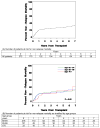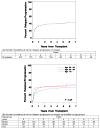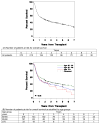Long-term outcomes among older patients following nonmyeloablative conditioning and allogeneic hematopoietic cell transplantation for advanced hematologic malignancies
- PMID: 22045765
- PMCID: PMC3217787
- DOI: 10.1001/jama.2011.1558
Long-term outcomes among older patients following nonmyeloablative conditioning and allogeneic hematopoietic cell transplantation for advanced hematologic malignancies
Abstract
Context: A minimally toxic nonmyeloablative regimen was developed for allogeneic hematopoietic cell transplantation (HCT) to treat patients with advanced hematologic malignancies who are older or have comorbid conditions.
Objective: To describe outcomes of patients 60 years or older after receiving minimally toxic nonmyeloablative allogeneic HCT.
Design, setting, and participants: From 1998 to 2008, 372 patients aged 60 to 75 years were enrolled in prospective clinical HCT trials at 18 collaborating institutions using conditioning with low-dose total body irradiation alone or combined with fludarabine, 90 mg/m(2), before related (n = 184) or unrelated (n = 188) donor transplants. Postgrafting immunosuppression included mycophenolate mofetil and a calcineurin inhibitor.
Main outcome measures: Overall and progression-free survival were estimated by Kaplan-Meier method. Cumulative incidence estimates were calculated for acute and chronic graft-vs-host disease, toxicities, achievement of full donor chimerism, complete remission, relapse, and nonrelapse mortality. Hazard ratios (HRs) were estimated from Cox regression models.
Results: Overall, 5-year cumulative incidences of nonrelapse mortality and relapse were 27% (95% CI, 22%-32%) and 41% (95% CI, 36%-46%), respectively, leading to 5-year overall and progression-free survival of 35% (95% CI, 30%-40%) and 32% (95% CI, 27%-37%), respectively. These outcomes were not statistically significantly different when stratified by age groups. Furthermore, increasing age was not associated with increases in acute or chronic graft-vs-host disease or organ toxicities. In multivariate models, HCT-specific comorbidity index scores of 1 to 2 (HR, 1.58 [95% CI, 1.08-2.31]) and 3 or greater (HR, 1.97 [95% CI, 1.38-2.80]) were associated with worse survival compared with an HCT-specific comorbidity index score of 0 (P = .003 overall). Similarly, standard relapse risk (HR, 1.67 [95% CI, 1.10-2.54]) and high relapse risk (HR, 2.22 [95% CI, 1.43-3.43]) were associated with worse survival compared with low relapse risk (P < .001 overall).
Conclusion: Among patients aged 60 to 75 years treated with nonmyeloablative allogeneic HCT, 5-year overall and progression-free survivals were 35% and 32%, respectively.
Conflict of interest statement
Figures



Comment in
-
Overcoming the age barrier in hematopoietic stem cell transplantation: progress, but still a long way to go.JAMA. 2011 Nov 2;306(17):1918-20. doi: 10.1001/jama.2011.1612. JAMA. 2011. PMID: 22045771 No abstract available.
-
Are reduced-intensity transplants safe in older patients with hematologic malignancies?Expert Rev Hematol. 2012 Apr;5(2):149-52. doi: 10.1586/ehm.12.9. Expert Rev Hematol. 2012. PMID: 22475283
Similar articles
-
Impact of postgrafting immunosuppressive regimens on nonrelapse mortality and survival after nonmyeloablative allogeneic hematopoietic stem cell transplant using the fludarabine and low-dose total-body irradiation 200-cGy.Biol Blood Marrow Transplant. 2007 Jul;13(7):790-805. doi: 10.1016/j.bbmt.2007.03.002. Epub 2007 Apr 23. Biol Blood Marrow Transplant. 2007. PMID: 17580257
-
Alloreactivity as therapeutic principle in the treatment of hematologic malignancies. Studies of clinical and immunologic aspects of allogeneic hematopoietic cell transplantation with nonmyeloablative conditioning.Dan Med Bull. 2007 May;54(2):112-39. Dan Med Bull. 2007. PMID: 17521527 Review.
-
Nonmyeloablative allogeneic hematopoietic stem cell transplant for the treatment of patients with hematologic malignancies using busulfan, fludarabine, and total body irradiation conditioning is effective in an elderly and infirm population.Biol Blood Marrow Transplant. 2015 Jan;21(1):89-96. doi: 10.1016/j.bbmt.2014.09.024. Epub 2014 Oct 16. Biol Blood Marrow Transplant. 2015. PMID: 25445641 Clinical Trial.
-
Allografting after nonmyeloablative conditioning as a treatment after a failed conventional hematopoietic cell transplant.Biol Blood Marrow Transplant. 2003 Apr;9(4):266-72. doi: 10.1053/bbmt.2003.50014. Biol Blood Marrow Transplant. 2003. PMID: 12720219 Clinical Trial.
-
Chimerism and outcomes after allogeneic hematopoietic cell transplantation following nonmyeloablative conditioning.Leukemia. 2006 Oct;20(10):1690-700. doi: 10.1038/sj.leu.2404335. Epub 2006 Jul 27. Leukemia. 2006. PMID: 16871276 Review.
Cited by
-
Referral to and receipt of allogeneic hematopoietic stem cell transplantation in older adults with acute myeloid leukemia.J Geriatr Oncol. 2023 Jan;14(1):101403. doi: 10.1016/j.jgo.2022.11.002. Epub 2022 Nov 10. J Geriatr Oncol. 2023. PMID: 36372724 Free PMC article.
-
The prognostic value of serum C-reactive protein, ferritin, and albumin prior to allogeneic transplantation for acute myeloid leukemia and myelodysplastic syndromes.Haematologica. 2016 Nov;101(11):1426-1433. doi: 10.3324/haematol.2016.145847. Epub 2016 Aug 4. Haematologica. 2016. PMID: 27662010 Free PMC article.
-
Novel risk assessment for the intensity of conditioning regimen in older patients.Blood Adv. 2023 Sep 12;7(17):4738-4747. doi: 10.1182/bloodadvances.2022008706. Blood Adv. 2023. PMID: 36508283 Free PMC article.
-
Current Status and Perspectives of Allogeneic Hematopoietic Stem Cell Transplantation in Elderly Patients with Acute Myeloid Leukemia.Stem Cells Transl Med. 2022 May 27;11(5):461-477. doi: 10.1093/stcltm/szac015. Stem Cells Transl Med. 2022. PMID: 35438781 Free PMC article. Review.
-
The association between the Arg280His polymorphism in the XRCC1 gene and the risk of hematological malignancies.Tumour Biol. 2014 Feb;35(2):1687-93. doi: 10.1007/s13277-013-1232-y. Epub 2013 Oct 6. Tumour Biol. 2014. PMID: 24096581
References
-
- Gratwohl A, Hermans J, Goldman JM, et al. Risk assessment for patients with chronic myeloid leukaemia before allogeneic blood or marrow transplantation. Lancet. 1998;352(9134):1087–1092. - PubMed
-
- SEER Cancer Statistics Review, 1975–2007. Bethesda, MD: National Cancer Institute; 2010. http://seer.cancer.gov/csr/1975_2007/, based on November 2009 SEER data submission, posted to the SEER web site.
-
- United States Cancer Statistics: 1999–2005 Incidence, WONDER Online Database. United States Department of Health and Human Services, Centers for Disease Control and Prevention and National Cancer Institute; 2008. http://wonder.cdc.gov/cancer-v2005.html.
-
- McSweeney PA, Niederwieser D, Shizuru JA, et al. Hematopoietic cell transplantation in older patients with hematologic malignancies: replacing high-dose cytotoxic therapy with graft-versus-tumor effects. Blood. 2001;97(11):3390–3400. - PubMed
-
- Maris MB, Niederwieser D, Sandmaier BM, et al. HLA-matched unrelated donor hematopoietic cell transplantation after nonmyeloablative conditioning for patients with hematologic malignancies. Blood. 2003;102(6):2021–2030. - PubMed

